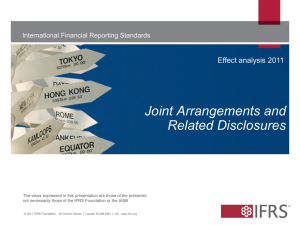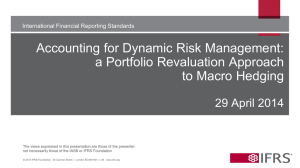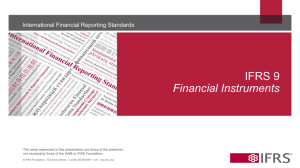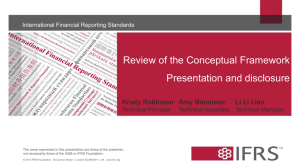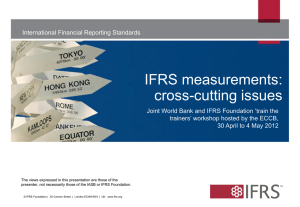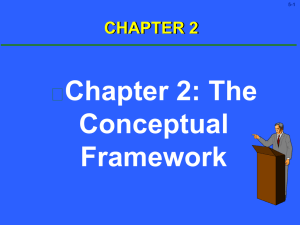Questions or comments?
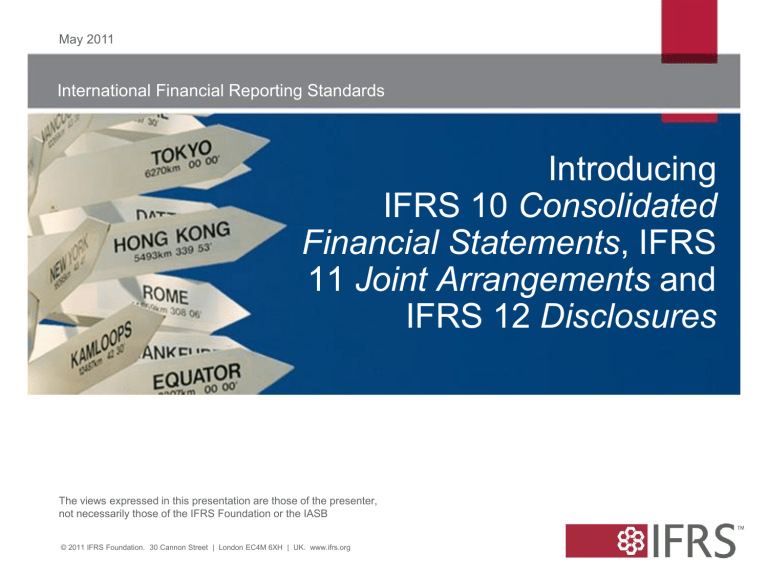
May 2011
International Financial Reporting Standards
Introducing
IFRS 10 Consolidated
Financial Statements , IFRS
11 Joint Arrangements and
IFRS 12 Disclosures
The views expressed in this presentation are those of the presenter, not necessarily those of the IFRS Foundation or the IASB
© 2011 IFRS Foundation. 30 Cannon Street | London EC4M 6XH | UK. www.ifrs.org
Housekeeping items
• Slides can be downloaded by clicking on the button below the slides window
• To ask a question, type into the designated text box on your screen and click “submit”
• Remember to turn off your pop-up blocker
• A recording of the webcast will be available online at www.ifrs.org
and www.fasb.org
• CPE credit is not available for this webcast
Important improvements
• IFRS 10,11 and 12 were published on 12 May 2011
• They create a consistent, principle based package for the involvement of companies with other entities
• Enhance convergence with US GAAP in key areas
• Conclude an important component of our response to the financial crisis
Interaction between IFRS 10,11,12, and IAS 28
Control alone?
yes no
Consolidation in accordance with IFRS 10
Disclosures in accordance with IFRS 12 yes
Joint control?
Define type of joint arrangement in accordance with IFRS 11
Joint Operation Joint Venture no
Significant influence?
yes
Account for assets, liabilities, revenues and expenses
Disclosures in accordance with IFRS
12
Account for an investment in accordance with IAS 28
Disclosures in accordance with
IFRS 12 no
4
IFRS 9
25 May 2011
Consolidated Financial
Statements and related
Disclosures
Why we undertook the project
Issues – IAS 27 / SIC12
Inconsistencies in practice
• Tension between IAS 27
(control) and SIC 12 (risk and rewards)
• Inconsistent application
Disclosures and financial crisis
• Sufficient guidance for structured entities?
• Reputational risk as a basis for consolidation?
• Inadequate disclosures?
Solution – IFRS 10, 12
• A single control model for all entities
• Clear principles of control
• Additional application guidance
• SIC 12 performed well. Use of existing principles to create a sound foundation for SPEs
• Enhanced disclosures particularly for unconsolidated structured entities
The control model – overview
Definition of control:
An investor controls an investee when the investor is exposed, or has rights, to variable returns from its involvement with the investee and has the ability to affect those returns through its power over the investee.
Single consolidation model for all entities, including structured entities
Consolidation based on control – ‘power so as to benefit’ model
Controller must have some exposure to risks and rewards.
Exposure is an indicator of control but is not control of itself
Power arises from rights
—voting rights (either majority or less than a majority), potential voting rights, other contractual arrangements, or a combination thereof.
Main decisions
1. “De facto” control
Entity can control with less than 50% of voting rights.
Factors to consider include:
– Size of the holding relative to the size and dispersion of other vote holders
– Potential voting rights
– Other contractual rights
If the above not conclusive consider additional facts and circumstances that provide evidence of power (eg voting patterns at previous board meeting, etc)
2. Structured entities
No separate guidance. General principles apply for assessing control for all types of entities.
Main decisions
3. Agency relationships
Consider all of the following factors :
– scope of the decision-making authority
– rights held by other parties (ie kick-out rights)
– remuneration of the decision-maker
– other interests that the decision maker holds in the investee
4. Disclosures
Enables investors to assess the nature of, and changes in, the risks associated with its interests in consolidated and unconsolidated structured entities
Improvements
Consistency and additional guidance
- Applying the definition of control
- Control without a majority of voting rights
- Agency relationships
Removal of ‘bright lines’
- Better reflection of the economic substance of the underlying relationship between entities
One disclosure package
– Enhanced disclosures and unified disclosure objectives in
IFRS 12 will provide useful information to capital markets and improves transparancy about the entity’s exposure to risk
25 May 2011
Joint Arrangements and related Disclosures
IAS 31
What needed to be improved?
• The structure of the arrangement is the only driver for the accounting
• When arrangements are structured in entities, preparers have an accounting option
This results in:
• arrangements that entitle the parties to similar rights and obligations are accounted for differently and, conversely,
• arrangements that entitle the parties to different rights and obligations are accounted for similarly.
© 2010 IFRS Foundation. 30 Cannon Street | London EC4M 6XH | UK. www.ifrs.org
IFRS 11
How does IFRS 11 improve on IAS 31?
• IFRS 11 establishes a clear principle that is applicable to the accounting for all joint arrangements.
The guiding principle:
A party to a joint arrangement recognises its rights and obligations arising from the arrangement.
• As a result: accounting options are eliminated.
© 2010 IFRS Foundation. 30 Cannon Street | London EC4M 6XH | UK. www.ifrs.org
IFRS 11
The assessments required
JOINT CONTROL
Do all the parties, or a group of the parties, have joint control over the arrangement?
Yes
No
Outside the scope of IFRS 11
Classification of the
JOINT ARRANGEMENT
Analysis of the parties’ rights and obligations arising from the arrangement
Joint Operation
Joint Venture
IFRS 11
Assessing joint control
Does the contractual arrangement give all the parties, or a group of the parties, control of the arrangement collectively?
No
Yes
Outside the scope of IFRS 11
Do the decisions about the relevant activities require the unanimous consent of all the parties, or of a group of the parties, that collectively control the arrangement?
No
Yes
Outside the scope of IFRS 11
The arrangement is jointly controlled the arrangement is a joint arrangement.
IFRS 11
Assessing the classification
Not structured through a separate vehicle
Structured through a separate vehicle
Assess the parties’ rights and obligations arising from the arrangement by considering:
(a) the legal form of the separate vehicle
(b) the terms of the contractual arrangement , and, if relevant,
(c) other facts and circumstances
Parties have rights to the assets and obligations for the liabilities
Parties have rights to the net assets
Joint operation Joint venture
Accounting for assets, liabilities, revenues and expenses in accordance with the contractual arrangements
Accounting for an investment using the equity method
IFRS 11
Improvements
• Enhanced verifiability and understandability
– the accounting reflects more faithfully the economic phenomena that it purports to represent
• Improved consistency
– it provides the same accounting outcome for each type of joint arrangement; and
• More comparability among financial statements
– it will enable users to identify and understand similarities in, and differences between,similar arrangements
IFRS 12
Disclosures for joint arrangements
Description of the nature, extent and the financial effects of an entity’s interests in joint arrangements
Joint operations Joint ventures
Summarised financial information for each individually material joint venture and in total for all other joint ventures.
Effective date
IFRS 10, IFRS 11, IFRS 12
• Aligned effective date for IFRS 10, IFRS 11 and
IFRS Annual periods beginning on or after 1
January 2013.
• Earlier application permitted.
– If an entity applies any of the IFRSs earlier, it is required to apply the other IFRSs at the same time.
© 2010 IFRS Foundation. 30 Cannon Street | London EC4M 6XH | UK. www.ifrs.org
Questions or comments?
Expressions of individual views by members of the
IASB and its staff are encouraged.
The views expressed in this presentation are those of the presenter. Official positions of the IASB on accounting matters are determined only after extensive due process and deliberation.
© 2008 IASC Foundation. 30 Cannon Street | London EC4M 6XH | UK. www.iasb.org
Questions or comments?
what happens if you don’t apply yet IFRS10,11 and 12?
© 2008 IASC Foundation. 30 Cannon Street | London EC4M 6XH | UK. www.iasb.org
Questions or comments?
Control will be about ability and not whether it is actually being exercised or not?
© 2008 IASC Foundation. 30 Cannon Street | London EC4M 6XH | UK. www.iasb.org
Questions or comments?
In IFRS 10, must ALL criteria be met to achieve control, (i.e. if power criteria is not satisfied, then no further evaluation is required as there can be no control) or must all criteria be evaluated simultaneously (i.e. it may not be conclusive that there is power, but the other criteria are satisfied, therefore the overall view can be taken that control exists)?
© 2008 IASC Foundation. 30 Cannon Street | London EC4M 6XH | UK. www.iasb.org
Questions or comments?
Why does the exposure to risks and rewards not in itself determine control?
© 2008 IASC Foundation. 30 Cannon Street | London EC4M 6XH | UK. www.iasb.org
Questions or comments?
How do you reconcile the guidance in §B13 when 2 or more investors have the current ability to direct relevant activities that occur at different times (e.g. R&D/regulatory approval of a medical product and, subsequently, manufacturing) with the definition of power in §10 (i.e. the current ability to direct the relevant activities)?
© 2008 IASC Foundation. 30 Cannon Street | London EC4M 6XH | UK. www.iasb.org
Questions or comments?
Question to IFRS 10: Is the definition "controlling the relevant activities of an entity" wider than " governing the financial and operating policies"?
© 2008 IASC Foundation. 30 Cannon Street | London EC4M 6XH | UK. www.iasb.org
Questions or comments?
.Do you think that IFRS 10 will lead to less SPEs being consolidated due to the addition of the power criterion to the actual criteria of SIC 12?
© 2008 IASC Foundation. 30 Cannon Street | London EC4M 6XH | UK. www.iasb.org
Questions or comments?
Are there plans for associates to be measured at fair value?
© 2008 IASC Foundation. 30 Cannon Street | London EC4M 6XH | UK. www.iasb.org
Questions or comments?
For IFRS 11, whenever the legal form of an entity ring-fences the rights and obligations of the parties to the JA, how can the arrangement be anything else than a joint venture?
© 2008 IASC Foundation. 30 Cannon Street | London EC4M 6XH | UK. www.iasb.org
Questions or comments?
What about jointly controlled assets in IAS 31, are they now part of joint operation?
© 2008 IASC Foundation. 30 Cannon Street | London EC4M 6XH | UK. www.iasb.org
Questions or comments?
Wouldn’t the rights to assets and obligations of liabilities be the same as rights to net assets under joint arrangements?
© 2008 IASC Foundation. 30 Cannon Street | London EC4M 6XH | UK. www.iasb.org
Questions or comments?
For joint arrangements that can no longer be proportionately consolidated, do the parties have to restate their financials to switch to equity method, as if the equity method was in place since the initial investment?
© 2008 IASC Foundation. 30 Cannon Street | London EC4M 6XH | UK. www.iasb.org
Questions or comments?
Is a joint operation required to do full consolidation or proportional consolidation?
© 2008 IASC Foundation. 30 Cannon Street | London EC4M 6XH | UK. www.iasb.org
Questions or comments?
Does IFRS 11 include the carve out for venture capital companies to continue to hold interests in a joint venture at fair value
© 2008 IASC Foundation. 30 Cannon Street | London EC4M 6XH | UK. www.iasb.org
Questions or comments?
Is there a rebuttable presumption that more than 50% holding means control unless proved otherwise.
© 2008 IASC Foundation. 30 Cannon Street | London EC4M 6XH | UK. www.iasb.org
Questions or comments?
When an entity has less than 50% voting rights, is the entity required to go and identify all other shareholders to determine whether they have de facto control? This could be quite an onerous requirement for companies
© 2008 IASC Foundation. 30 Cannon Street | London EC4M 6XH | UK. www.iasb.org
Questions or comments?
What will happen to entity that are consolidated under risk and reward model. Will they cease to be consolidated if they prefer to early adopt?
© 2008 IASC Foundation. 30 Cannon Street | London EC4M 6XH | UK. www.iasb.org
